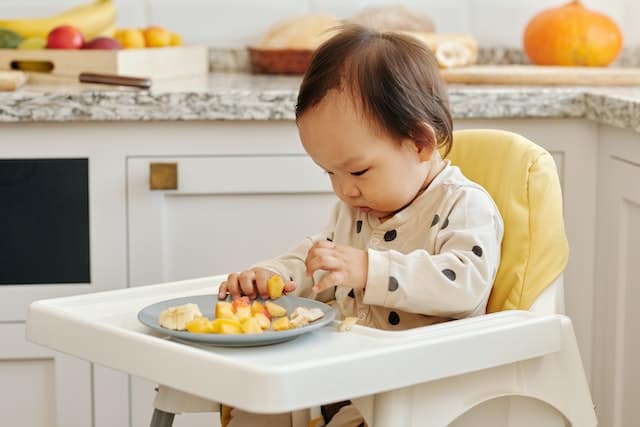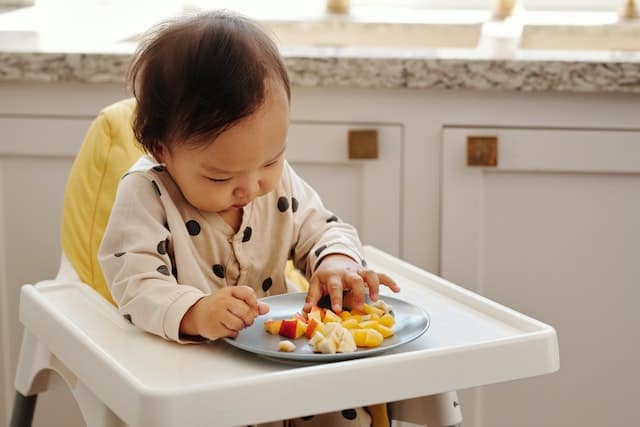Baby-led weaning (BLW) is a feeding approach that allows infants to self-feed solid foods from the start of their weaning journey. The BLW method involves offering a variety of nutritious finger foods to the baby and letting them explore and feed themselves at their own pace.
This approach is gaining popularity among parents as it promotes independence, develops fine motor skills, and encourages a positive relationship with food.
Understanding the signs of readiness for BLW is crucial to ensure a safe and successful feeding experience for the baby. Some of the signs that indicate a baby is ready for BLW include sitting up unsupported, showing interest in food, reaching for and grabbing food, and bringing food to their mouth.
However, it is important to note that BLW may not be suitable for all babies, and consulting a pediatrician before starting is recommended.
Key Takeaways
- BLW is a feeding approach that involves offering solid foods to infants and allowing them to self-feed.
- Knowing the signs of readiness for BLW is important to ensure a safe and successful feeding experience for the baby.
- Consulting a pediatrician before starting BLW and being aware of potential challenges and safety measures is recommended.
Understanding Baby-Led Weaning

Baby-led weaning (BLW) is a self-feeding method of introducing solid foods to babies. Unlike traditional weaning, where pureed foods are spoon-fed to the baby, BLW allows the baby to feed themselves. The baby is given soft, easy-to-grasp finger foods, and they learn to chew and swallow at their own pace.
BLW is based on the belief that babies are capable of feeding themselves and have an innate ability to regulate their food intake. It allows babies to explore different textures, tastes, and smells of food, which can help them develop a healthy relationship with food.
Pediatricians recommend BLW as a safe and effective way to introduce solid foods to babies. However, it’s important to ensure that the baby is developmentally ready before starting BLW. Signs of readiness include:
- The baby can sit up unsupported
- The baby has good head control
- The baby is showing an interest in food
- The baby is able to grasp and bring food to their mouth
It’s important to note that BLW is not suitable for all babies. Babies with certain medical conditions or developmental delays may need to follow a different weaning approach.
BLW can offer many benefits to both the baby and the parents. It can help the baby develop fine motor skills, hand-eye coordination, and oral motor skills. It can also make mealtimes more enjoyable for both the baby and the parents.
In summary, BLW is a self-feeding approach to introducing solid foods to babies. It can help babies develop a healthy relationship with food and offers many benefits to both the baby and the parents.
However, it’s important to ensure that the baby is developmentally ready before starting BLW. Pediatricians recommend BLW as a safe and effective way to introduce solid foods to babies.
Signs of Readiness for BLW
When it comes to introducing solid foods to infants, parents may consider baby-led weaning (BLW) as an option. BLW is a method of feeding solids that involves allowing the baby to feed themselves from the start.
Before starting BLW, it is important to look for signs of readiness in the baby. Here are some signs to look for:
1. Physical Readiness
The baby should be able to sit up with minimal support and have good head control. This is important because the baby needs to be able to sit upright to eat and swallow food safely. If the baby is not able to sit up on their own, they may not be ready for BLW.
2. Developmental Readiness
The baby should have developed some oral motor skills, including chewing movements and the ability to move food around in their mouth. The tongue-thrust reflex, which pushes food out of the mouth, should also have diminished.
Additionally, the baby should be at least 6 months old and have shown signs of growth and development.
It is important to note that some babies may show signs of readiness before 6 months, but it is recommended to wait until this age to start BLW. This is because the baby’s digestive system is not fully developed before 6 months, and starting solids too early can increase the risk of allergies and other health problems.
3. Fine Motor Skills and Hand-Eye Coordination
BLW requires the baby to pick up food and bring it to their mouth. Therefore, the baby should have developed some fine motor skills and hand-eye coordination. This means that the baby should be able to grasp objects and bring them to their mouth without choking hazards.
In conclusion, before starting BLW, parents should look for signs of readiness in their baby. These signs include physical readiness, developmental readiness, and fine motor skills and hand-eye coordination.
It is important to wait until the baby is at least 6 months old and has shown signs of growth and development before starting BLW.
The Role of Nutrition in BLW

1. Importance of Breastmilk and Formula
Breastmilk or formula should remain the primary source of nutrition for infants until they are six months old. The American Academy of Pediatrics recommends exclusive breastfeeding for the first six months of life, followed by the introduction of complementary foods.
Breastmilk and formula provide the necessary nutrients for infants to grow and develop properly.
2. Transition to Solids
When starting solids, it is important to continue to offer breastmilk or formula alongside solid foods. This ensures that the infant is still receiving the necessary nutrients for their growth and development.
Solids should be introduced gradually, one food at a time, to allow the infant to adjust to the new textures and flavors.
3. Variety of Foods
Offering a variety of nutrient-dense foods is important for the infant’s growth and development. Fruits, vegetables, and meats are all good sources of important nutrients, such as iron and energy. Introducing a variety of foods early on can also help to prevent picky eating habits later in life.
In summary, breastmilk or formula should remain the primary source of nutrition for infants until they are six months old. When starting solids, it is important to continue to offer breastmilk or formula alongside solid foods. Offering a variety of nutrient-dense foods is important for the infant’s growth and development.
Safety Measures for BLW
When it comes to Baby-Led Weaning (BLW), safety is of utmost importance. Parents should take necessary precautions to ensure that their baby is safe during mealtime.
This section covers some safety measures that parents can follow while practicing BLW.
1. Preventing Choking
Choking is a significant concern during BLW, as babies are given solid foods that they need to chew and swallow. To prevent choking, parents should follow these safety measures:
- Always supervise the baby during mealtime.
- Ensure that the baby is sitting upright in a high chair or on the floor.
- Cut the food into small, manageable pieces.
- Avoid giving foods that are round, hard, or sticky, such as nuts, popcorn, or chewing gum.
- Encourage the baby to chew their food properly before swallowing.
Parents should also consider taking an infant CPR course to be prepared for any choking emergencies that may arise.
2. Safe Foods for BLW
When it comes to BLW, parents must choose safe foods that are appropriate for their baby’s age and development. Here are some safe foods for BLW:
- Soft fruits and vegetables, such as bananas, avocados, and cooked sweet potatoes.
- Cooked and shredded meats, such as chicken and beef.
- Toast, crackers, and other soft finger foods.
- Cooked pasta, rice, and other grains.
Parents should avoid giving their baby foods that are high in salt, sugar, or fat. They should also be cautious when introducing new foods and watch for any signs of allergic reactions.
In conclusion, following these safety measures can help parents ensure that their baby is safe during BLW. By choosing safe foods and supervising the baby during mealtime, parents can help their baby develop healthy eating habits and enjoy mealtime.
Feeding Process in BLW

1. Self-Feeding
In baby-led weaning, the focus is on allowing the baby to feed themselves. This means that the baby is given the opportunity to grasp and manipulate food with their hands, and bring it to their mouths independently. This process helps to develop fine motor skills and hand-eye coordination.
When a baby is ready to self-feed, they will show signs of being able to sit up unassisted, have good head control, and have developed the ability to grasp objects.
It is important to note that not all babies will be ready to self-feed at the same age, and it is important to follow the baby’s lead and not force them to do anything they are not ready for.
2. Responsive Feeding
Responsive feeding is an important aspect of baby-led weaning. This means that the caregiver is responsive to the baby’s hunger and fullness cues, and allows the baby to control their own food intake.
This helps to promote a healthy relationship with food, and encourages the baby to listen to their own body’s signals.
During mealtime, it is important to provide a variety of healthy foods for the baby to choose from, and to allow them to decide how much they want to eat. It is also important to provide support and guidance as needed, but not to take over or control the feeding process.
Family mealtime is an important part of responsive feeding. It allows the baby to observe and learn from the eating habits of others, and to feel included in the mealtime experience.
It is important to make mealtime a positive and enjoyable experience for the baby, and to avoid pressuring them to eat or using food as a reward or punishment.
In summary, the feeding process in baby-led weaning focuses on self-feeding and responsive feeding. This helps to promote independence and a healthy relationship with food.
By providing support and guidance as needed, and allowing the baby to control their own food intake, caregivers can help to foster a positive mealtime experience for the whole family.
Potential Challenges and Solutions
1. Gagging vs Choking
One of the challenges of BLW is that babies may gag or choke on foods that are not pureed. Gagging is a normal part of learning to eat and is not the same as choking. Gagging is when a baby’s body reacts to food being too far back in the mouth, causing them to cough or gag.
Choking is when food gets stuck in the throat and the baby cannot breathe.
To prevent choking, parents should always supervise their baby during mealtimes and make sure that they are sitting upright. It is also important to cut foods into small pieces and avoid giving foods that are hard or round, such as nuts or grapes.
If a baby does choke, parents should know how to perform infant CPR and seek medical attention immediately.
2. Fussy Eaters
Another potential challenge of BLW is that some babies may be fussy eaters and refuse to eat certain foods. This can be frustrating for parents who want their baby to eat a variety of healthy foods.
One solution is to offer a variety of foods and let the baby choose what they want to eat. It is also important to be patient and not force the baby to eat. If a baby is hungry, they will eat. It may take several tries before a baby will accept a new food, so parents should continue to offer it.
3. Weight Gain and Obesity
Some parents may worry that BLW may lead to their baby not gaining enough weight or becoming obese. However, studies have shown that babies who are introduced to solid foods using BLW are no more likely to be overweight than those who are fed pureed foods.
To ensure that a baby is getting enough nutrition, parents should offer a variety of healthy foods and monitor their baby’s weight gain. It is also important not to force a baby to eat if they are full. Babies have a natural ability to regulate their appetite, so parents should trust their baby’s hunger and fullness cues.
Consulting a Pediatrician
When it comes to starting baby-led weaning (BLW), parents might have questions about whether their baby is ready to start solid foods. In this case, it is always recommended to consult with a pediatrician.
A pediatrician can help assess the baby’s readiness for solid foods and provide guidance on how to proceed.
Pediatricians are trained to identify any underlying health issues that could affect a baby’s ability to eat solid foods. They can also provide advice on how to introduce new foods and monitor any potential allergic reactions.
If a baby is currently dealing with an illness or has recently recovered from one, it is important to consult with a pediatrician before starting BLW. The pediatrician can advise on the best time to introduce solid foods and how to ensure that the baby is getting the necessary nutrients to support their recovery.
Pediatricians can also provide guidance on developmental milestones that may affect a baby’s ability to eat solid foods. For example, if a baby has not yet developed the necessary motor skills to pick up and chew foods, the pediatrician may recommend waiting a bit longer before starting BLW.
Distractions can also be a concern when starting BLW. Pediatricians can provide tips on how to minimize distractions during mealtime to help the baby focus on eating.
Finally, pediatricians can offer advice on how to set up a safe and comfortable feeding environment. This may include using a highchair or booster seat and ensuring that the baby’s digestive system is ready for solid foods.
Overall, consulting with a pediatrician can provide parents with the confidence and knowledge they need to start BLW safely and effectively.
Related Posts:
Frequently Asked Questions
What are the signs that a baby is ready for solid foods?
There are several signs that a baby is ready for solid foods. These include being able to sit up on their own, having good head control, being interested in food, and being able to pick up food and bring it to their mouth.
It’s important to note that every baby is different, so it’s best to look for a combination of these signs rather than relying on just one.
How can I tell if my baby is ready for baby-led weaning?
If your baby is showing the signs of readiness for solid foods mentioned above, they may be ready for baby-led weaning. Baby-led weaning involves offering soft, easy-to-grasp foods that your baby can feed themselves.
It’s important to make sure that your baby is able to sit up on their own and has good head control before trying baby-led weaning.
What are some starter foods for baby-led weaning?
Some good starter foods for baby-led weaning include soft fruits and vegetables like avocado, banana, and cooked sweet potato. You can also offer soft, cooked meats like chicken or fish, or small pieces of cheese.
It’s important to make sure that the food is cut into small, easy-to-grasp pieces and cooked until it’s soft enough for your baby to chew.
What high chair is best for baby-led weaning?
When choosing a high chair for baby-led weaning, it’s important to look for one that is sturdy and easy to clean. A high chair with a removable tray can be helpful, as it allows you to easily clean up any messes. Some popular high chairs for baby-led weaning include the IKEA Antilop and the Stokke Tripp Trapp.
When should I introduce purees to my baby?
If you choose to introduce purees to your baby, it’s generally recommended to wait until around 6 months of age. At this age, most babies will have the necessary developmental skills to be able to swallow pureed foods.
It’s important to start with simple, single-ingredient purees and gradually introduce new flavors and textures over time.
What are some signs that my baby isn’t ready for solids?
If your baby isn’t showing the signs of readiness for solid foods mentioned above, they may not be ready for solids yet. Some signs that your baby isn’t ready for solids include pushing food out of their mouth, gagging or choking on food, or not being able to sit up on their own.
If you’re unsure whether your baby is ready for solids, it’s always best to check with your pediatrician.

Iesha is a loving mother of 2 beautiful children. She’s an active parent who enjoys indoor and outdoor adventures with her family. Her mission is to share practical and realistic parenting advice to help the parenting community becoming stronger.
